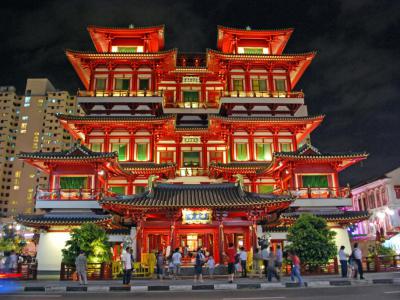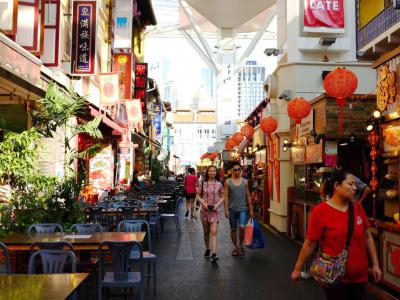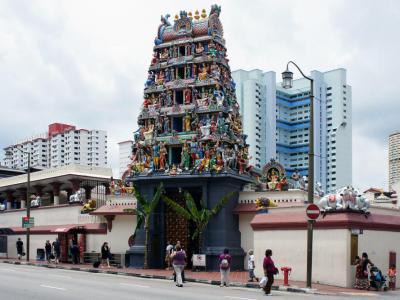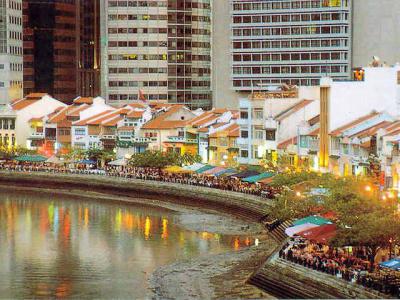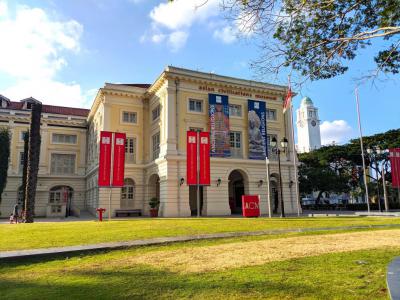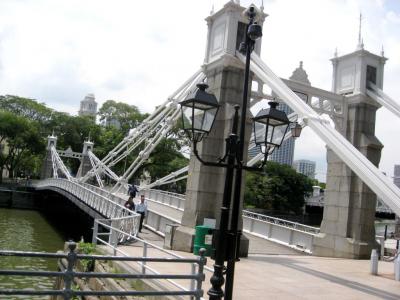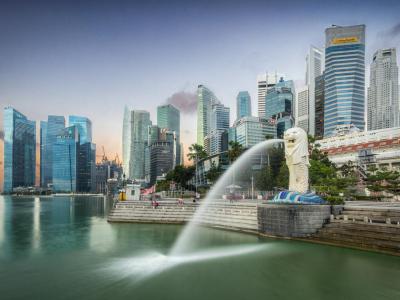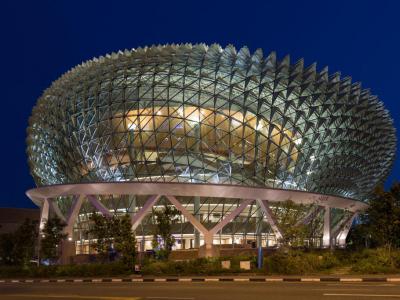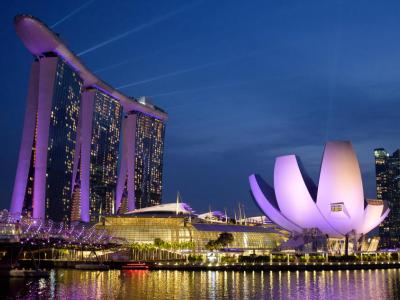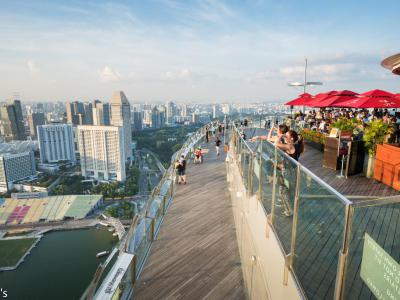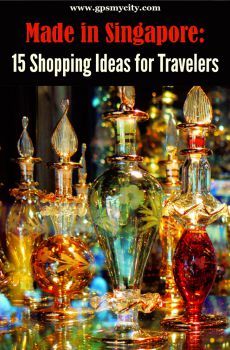
Singapore Introduction Walking Tour (Self Guided), Singapore
Malay legend has it that a long time ago the Sumatran prince, who sought shelter from a storm, ended up on the island of Temasek where he saw a strange animal believed to be a lion. He then founded a city there and named it Singapura which in Sanskrit means the “Lion City”. In the 14th century, Singapura found itself “between a rock and a hard place” when the neighboring realms of Thailand and Java struggled for control over the Malay Peninsula, which subsequently reduced the city to an obscure fishing settlement.
Devoid of any noteworthy natural resources, Singapore acquired initial wealth courtesy of the robust free trade policy enacted in 1819 by Sir Stamford Raffles, administrator of British East India, who took advantage of the island’s superb natural harbor and strategic position on the maritime route between China and India and set up a British trading post here. The port thrived from the very beginning and, to this day, remains one of the busiest in the world.
As with neighboring Malaysia, much of the foreign fascination with Singapore comes from its multicultural population, comprising the Chinese, Malay, and Indians. This ethnic diversity is so that a one-hour walk across the city, passing through Chinese and Indian quarters, may result in feeling like you're hopping from one country to another. Excellent historical museums and colonial architecture, as well as great waterfront shopping and dining opportunities also add to the appeal and can keep visitors occupied for days.
This self-guided tour takes you through some of the most popular tourist attractions of Singapore, the majority of which are located along the Singapore River, small but of a great historical importance. To obtain directions to the sights in question, tap the sight's name below this introduction and then tap it on the map at the bottom of the sight's information screen. The GPS navigation function will guide you to the chosen destination.
Devoid of any noteworthy natural resources, Singapore acquired initial wealth courtesy of the robust free trade policy enacted in 1819 by Sir Stamford Raffles, administrator of British East India, who took advantage of the island’s superb natural harbor and strategic position on the maritime route between China and India and set up a British trading post here. The port thrived from the very beginning and, to this day, remains one of the busiest in the world.
As with neighboring Malaysia, much of the foreign fascination with Singapore comes from its multicultural population, comprising the Chinese, Malay, and Indians. This ethnic diversity is so that a one-hour walk across the city, passing through Chinese and Indian quarters, may result in feeling like you're hopping from one country to another. Excellent historical museums and colonial architecture, as well as great waterfront shopping and dining opportunities also add to the appeal and can keep visitors occupied for days.
This self-guided tour takes you through some of the most popular tourist attractions of Singapore, the majority of which are located along the Singapore River, small but of a great historical importance. To obtain directions to the sights in question, tap the sight's name below this introduction and then tap it on the map at the bottom of the sight's information screen. The GPS navigation function will guide you to the chosen destination.
How it works: Download the app "GPSmyCity: Walks in 1K+ Cities" from Apple App Store or Google Play Store to your mobile phone or tablet. The app turns your mobile device into a personal tour guide and its built-in GPS navigation functions guide you from one tour stop to next. The app works offline, so no data plan is needed when traveling abroad.
Singapore Introduction Walking Tour Map
Guide Name: Singapore Introduction Walking Tour
Guide Location: Singapore » Singapore (See other walking tours in Singapore)
Guide Type: Self-guided Walking Tour (Sightseeing)
# of Attractions: 10
Tour Duration: 2 Hour(s)
Travel Distance: 3.5 Km or 2.2 Miles
Author: vickyc
Sight(s) Featured in This Guide:
Guide Location: Singapore » Singapore (See other walking tours in Singapore)
Guide Type: Self-guided Walking Tour (Sightseeing)
# of Attractions: 10
Tour Duration: 2 Hour(s)
Travel Distance: 3.5 Km or 2.2 Miles
Author: vickyc
Sight(s) Featured in This Guide:
- Buddha Tooth Relic Temple & Museum
- Smith Street (Chinatown Food Street)
- Sri Mariamman Temple
- Boat Quay
- Asian Civilisations Museum
- Cavenagh Bridge
- Merlion Park and Statue
- Esplanade – Theatres on the Bay
- Marina Bay
- Sands Skypark and Observation Deck
1) Buddha Tooth Relic Temple & Museum (must see)
Located in Singapore's Chinatown, this opulent cultural monument is cherished by the local Chinese who make up the overwhelming majority of the city-state's population. The temple's majestic outside appearance is equally matched on the inside.
Always lit up at night, it is open to visitors 24 hours a day. The dress code is strict and demands women to cover their shoulders, with a conservative dress or slacks advised for the lower part. Likewise, men are prohibited from wearing shorts or tank-tops, but oddly enough shoes are permitted for all, as are non-flash photos in some places.
Locals go in to pray regularly and you may find here a monk conducting a prayer or chanting in a microphone quite often. Set in the rear are the statues of Buddhas each overseeing a certain astrological sign, but the key figure in the main hall is Maitreya, a Buddha that is yet to come to Earth, the wooden statue of which here is believed to be 1,000 years old.
One of the temple's floors is fully filled with statues, among which is that of Guan Yin – Chinese Bodhisattva, Goddess of Compassion, Mercy and Kindness. Further up, in the mezzanine, there are life-sized wax sculptures of present and past leaders of the Temple – quite rich in detail actually (even showing wrinkles on hands!) and fit to rival any wax museum in the world. Also here is a balcony from which one can observe, through the drapes, the huge main prayer room down below, on the 1st floor.
Finally, the 4th floor is where the ultimate treasure of the temple is found – the Sacred Buddha Tooth Relic Stupa reportedly containing a tooth of Gautama Buddha himself, discovered in 1980 at a Burmese monastery. Now encased in a golden chamber behind glass panels, it can't be inspected up close, but there is an accompanying scale model at the front which can be viewed at any time.
Another must-see within the temple is the orchid garden on the rooftop featuring an enormous “prayer wheel” inside a pavilion of 10,000 small Buddhas lining the walls. Most people aren't aware of this garden, so it is very quiet and relaxing up here – an ideal setting for reflection prior to hitting the streets of Singapore's Chinatown once again.
Tip:
Non-flash-photos are permitted in some places, but not in the relic chamber.
Always lit up at night, it is open to visitors 24 hours a day. The dress code is strict and demands women to cover their shoulders, with a conservative dress or slacks advised for the lower part. Likewise, men are prohibited from wearing shorts or tank-tops, but oddly enough shoes are permitted for all, as are non-flash photos in some places.
Locals go in to pray regularly and you may find here a monk conducting a prayer or chanting in a microphone quite often. Set in the rear are the statues of Buddhas each overseeing a certain astrological sign, but the key figure in the main hall is Maitreya, a Buddha that is yet to come to Earth, the wooden statue of which here is believed to be 1,000 years old.
One of the temple's floors is fully filled with statues, among which is that of Guan Yin – Chinese Bodhisattva, Goddess of Compassion, Mercy and Kindness. Further up, in the mezzanine, there are life-sized wax sculptures of present and past leaders of the Temple – quite rich in detail actually (even showing wrinkles on hands!) and fit to rival any wax museum in the world. Also here is a balcony from which one can observe, through the drapes, the huge main prayer room down below, on the 1st floor.
Finally, the 4th floor is where the ultimate treasure of the temple is found – the Sacred Buddha Tooth Relic Stupa reportedly containing a tooth of Gautama Buddha himself, discovered in 1980 at a Burmese monastery. Now encased in a golden chamber behind glass panels, it can't be inspected up close, but there is an accompanying scale model at the front which can be viewed at any time.
Another must-see within the temple is the orchid garden on the rooftop featuring an enormous “prayer wheel” inside a pavilion of 10,000 small Buddhas lining the walls. Most people aren't aware of this garden, so it is very quiet and relaxing up here – an ideal setting for reflection prior to hitting the streets of Singapore's Chinatown once again.
Tip:
Non-flash-photos are permitted in some places, but not in the relic chamber.
2) Smith Street (Chinatown Food Street) (must see)
Singapore's Chinatown abounds in eateries of various sort which are particularly diverse in the heart of the area, right on and around South Bridge Road. A few touts on Smith Street will try to lure you into some foreigner-friendly restaurants, all decent enough if not the best in their class, and varied enough to eat something different every day for a few weeks. So if you want a great selection of different Asian cuisines, head to Smith Street and dine your way around South East Asia with ease. Give the hawker stalls along the road a miss if looking for genuine local food, even though they're also quite delicious and relatively cheap.
You could start off the day with a Michelin-star hawker lunch at Liao Fan Hawker Chan; next, you could leave the restaurant and roam the streets for unique souvenirs that are much cheaper and affordable, compared to other places. There are several tea shops, craft beer stalls, and many other Chinese shops set in the historical shop-houses, and you will also be able to buy a Durian fruit here or taste Durian ice cream if you're feeling adventurous.
Wherever you choose to go, you won't feel intimidated or pressurized to buy unlike in many other countries. Curiously enough for a street with so much authentic fare, Smith Street is the only street in Chinatown with an English name.
You could start off the day with a Michelin-star hawker lunch at Liao Fan Hawker Chan; next, you could leave the restaurant and roam the streets for unique souvenirs that are much cheaper and affordable, compared to other places. There are several tea shops, craft beer stalls, and many other Chinese shops set in the historical shop-houses, and you will also be able to buy a Durian fruit here or taste Durian ice cream if you're feeling adventurous.
Wherever you choose to go, you won't feel intimidated or pressurized to buy unlike in many other countries. Curiously enough for a street with so much authentic fare, Smith Street is the only street in Chinatown with an English name.
3) Sri Mariamman Temple
Singapore’s oldest Hindu shrine, the Sri Mariamman Temple, is easily identified by the superb entrance “gopura” bristling with brightly colored deities. Located in the Chinatown district, the temple serves the majority Hindu Singaporeans, known as Tamilians.
Once inside, look up at the roof and you will see splendid friezes depicting a host of Hindu deities, including the three manifestations of the supreme being: Brahma the creator, with three of his four heads showing; Vishnu the preserver, and Shiva the destroyer, the latter holding one of his sons. The main sanctum, facing you as you walk inside the temple, is devoted to Mariamman, a goddess worshiped for her healing powers. Smaller sanctums dotted all around the temple's walkway honor a number of other deities. In the one dedicated to the goddess Periachi Amman, a sculpture portrays her with a queen lying on her lap, whose evil child she has ripped from her womb, which is most interesting given that Periachi Amman is the protector of children, to whom babies are brought when they're only one month old. Sri Aravan, with his bushy mustache and big ears, is far less intimidating and his sanctum is at the back of the complex.
To the left of the main sanctum is a patch of sand which once a year, during the festival of Thimithi (in October or November), is covered in red-hot coals that male Hindus run across to prove the strength of their faith. The participants, who line up all the way along South Bridge Road waiting for their turn, are supposedly protected from the heat of the coals by the power of prayer.
If you go during certain times you will see different interesting rituals almost every day. Visiting here is guaranteed to be a great, culturally-enlightening experience. As in any place of worship, you must be respectful toward locals and follow their lead. Lowered voices, covered shoulders, and removed shoes are generally required, but bringing a pair of socks would probably help the more sensitive, as the floors can be scorching hot due to the sun and burn the feet.
Why You Should Visit:
If you go during certain times you will see different interesting rituals almost every day.
Visiting here is guaranteed to be a great, culturally-enlightening experience.
Free to enter though there's a small charge for tourists – called a "camera fee".
Tip:
As in any place of worship, you must be respectful toward locals and follow their lead. Lowered voices, covered shoulders, and removed shoes are generally required, but bringing a pair of socks would probably help the more sensitive, as the floors can be scorching hot due to the sun and burn the feet.
Once inside, look up at the roof and you will see splendid friezes depicting a host of Hindu deities, including the three manifestations of the supreme being: Brahma the creator, with three of his four heads showing; Vishnu the preserver, and Shiva the destroyer, the latter holding one of his sons. The main sanctum, facing you as you walk inside the temple, is devoted to Mariamman, a goddess worshiped for her healing powers. Smaller sanctums dotted all around the temple's walkway honor a number of other deities. In the one dedicated to the goddess Periachi Amman, a sculpture portrays her with a queen lying on her lap, whose evil child she has ripped from her womb, which is most interesting given that Periachi Amman is the protector of children, to whom babies are brought when they're only one month old. Sri Aravan, with his bushy mustache and big ears, is far less intimidating and his sanctum is at the back of the complex.
To the left of the main sanctum is a patch of sand which once a year, during the festival of Thimithi (in October or November), is covered in red-hot coals that male Hindus run across to prove the strength of their faith. The participants, who line up all the way along South Bridge Road waiting for their turn, are supposedly protected from the heat of the coals by the power of prayer.
If you go during certain times you will see different interesting rituals almost every day. Visiting here is guaranteed to be a great, culturally-enlightening experience. As in any place of worship, you must be respectful toward locals and follow their lead. Lowered voices, covered shoulders, and removed shoes are generally required, but bringing a pair of socks would probably help the more sensitive, as the floors can be scorching hot due to the sun and burn the feet.
Why You Should Visit:
If you go during certain times you will see different interesting rituals almost every day.
Visiting here is guaranteed to be a great, culturally-enlightening experience.
Free to enter though there's a small charge for tourists – called a "camera fee".
Tip:
As in any place of worship, you must be respectful toward locals and follow their lead. Lowered voices, covered shoulders, and removed shoes are generally required, but bringing a pair of socks would probably help the more sensitive, as the floors can be scorching hot due to the sun and burn the feet.
4) Boat Quay
The historic Boat Quay in Singapore, upstream from the mouth of the Singapore River was once the busiest part of the city's old port – a true center of commerce handling three-quarters of all shipping business back in the 1860s. Because the southern part of the river resembles the belly of a carp, which according to Chinese belief is where wealth and prosperity lay, many shop-houses were built in the area, making it quite crowded.
Although maritime trade is no longer Boat Quay's primary role, the shop-houses here remain and now, carefully conserved, accommodate colorful restaurants, bars and shops of various sort. Thus the area's social-economic role has shifted towards tourism seeing the commercial zone enclose the Singapore River. As such, this is an example of successful urban regeneration, given that in the early 1990s the area was derelict.
It is here, in the Boat Quay, that you will find the most atmospheric riverfront restaurants serving all manner of Singaporean delicacies. There are also German, Indian and Korean foods on offer, as well as heaping plates of seafood to choose from; or, if you just want to watch the boats go by with a pint, that is perfect either. On top of that, visitors get a scenic view of the Financial District and the river and, with such a stunning location, it is good to walk along this shore on a nice balmy night, too.
Tip:
Before ordering food in the Boat Quay, just make sure to ask about the price or pre-agree it, as many things here are charged per 100 grams and you may end up paying exorbitant prices at some restaurants! Keep in mind that if you venture just a little further down the road, to one of the more local street food venues, you might get just as richly rewarded for a smaller bill.
Although maritime trade is no longer Boat Quay's primary role, the shop-houses here remain and now, carefully conserved, accommodate colorful restaurants, bars and shops of various sort. Thus the area's social-economic role has shifted towards tourism seeing the commercial zone enclose the Singapore River. As such, this is an example of successful urban regeneration, given that in the early 1990s the area was derelict.
It is here, in the Boat Quay, that you will find the most atmospheric riverfront restaurants serving all manner of Singaporean delicacies. There are also German, Indian and Korean foods on offer, as well as heaping plates of seafood to choose from; or, if you just want to watch the boats go by with a pint, that is perfect either. On top of that, visitors get a scenic view of the Financial District and the river and, with such a stunning location, it is good to walk along this shore on a nice balmy night, too.
Tip:
Before ordering food in the Boat Quay, just make sure to ask about the price or pre-agree it, as many things here are charged per 100 grams and you may end up paying exorbitant prices at some restaurants! Keep in mind that if you venture just a little further down the road, to one of the more local street food venues, you might get just as richly rewarded for a smaller bill.
5) Asian Civilisations Museum
The robust former Empress Place Building, located at the mouth of the Singapore River, is one of the city's architectural treasures – elegantly proportioned and symmetrically laid out, adorned with many decorative features, such as exquisite plaster mouldings, architraves, and cornices. Completed in 1867 and named after Queen Victoria, it still wears the original Neoclassical Palladian exterior, despite having undergone a series of renovations and extensions, featuring same Roman Doric facade for the principal storey with pitched clay tile roofs, arcaded verandahs and timber-louvered French windows that used to keep the interior cool and well ventilated in Singapore’s tropical climate before air-conditioners were installed and which caught the attention of many migrants sailing into Singapore harbor over the years.
Today, this white two-storey edifice houses the Asian Civilisations Museum that ambitiously tries to pull together the various threads of Asian civilizations, from the Middle East to China, thus helping to better understand and appreciate all the different cultures that went into making Singaporeans what they are – a cosmopolitan nation.
Informative and well-presented, with special exhibits not often seen in public, this museum has a few highlights worth mentioning, starting with the Hindu-Buddhist gallery and its beautifully-lit displays featuring a stunning 18th-century Burmese Buddha head and a large bronze drum. The Chinese influences are also well represented, from tomb remains to ceramics over a thousand years old that have been recovered from a shipwreck found in 1998. All in all, the recovered cargo comprises more than 60,000 well-preserved pieces, including gold and silver items produced in China during the Tang dynasty. In the small Malay World section, look out for a spectacular Kelantan Makara, a huge goggle-eyed mongrel creature once used in rituals, while elsewhere you will find exquisite examples of porcelain, textiles, lacquerware, costumes and traditional huge procession statues.
The museum also has a restaurant, called “Empress”, serving traditional Chinese cuisine in a contemporary waterfront setting, plus a cafe, called “Privé ACM”, where you can relax at the alfresco area, enjoying view of the Singapore River and the city's business district skyline. The museum shop carries souvenirs and a wide range of books on Asian art.
Tip:
You can take one of the free English tours which are very worthwhile, usually beginning in June and running at 11:30am, 1:30pm, and 3pm most days; and if you plan to go to more than one museum, consider getting a multi-museum pass while you're here.
Today, this white two-storey edifice houses the Asian Civilisations Museum that ambitiously tries to pull together the various threads of Asian civilizations, from the Middle East to China, thus helping to better understand and appreciate all the different cultures that went into making Singaporeans what they are – a cosmopolitan nation.
Informative and well-presented, with special exhibits not often seen in public, this museum has a few highlights worth mentioning, starting with the Hindu-Buddhist gallery and its beautifully-lit displays featuring a stunning 18th-century Burmese Buddha head and a large bronze drum. The Chinese influences are also well represented, from tomb remains to ceramics over a thousand years old that have been recovered from a shipwreck found in 1998. All in all, the recovered cargo comprises more than 60,000 well-preserved pieces, including gold and silver items produced in China during the Tang dynasty. In the small Malay World section, look out for a spectacular Kelantan Makara, a huge goggle-eyed mongrel creature once used in rituals, while elsewhere you will find exquisite examples of porcelain, textiles, lacquerware, costumes and traditional huge procession statues.
The museum also has a restaurant, called “Empress”, serving traditional Chinese cuisine in a contemporary waterfront setting, plus a cafe, called “Privé ACM”, where you can relax at the alfresco area, enjoying view of the Singapore River and the city's business district skyline. The museum shop carries souvenirs and a wide range of books on Asian art.
Tip:
You can take one of the free English tours which are very worthwhile, usually beginning in June and running at 11:30am, 1:30pm, and 3pm most days; and if you plan to go to more than one museum, consider getting a multi-museum pass while you're here.
6) Cavenagh Bridge
Spanning the Singapore River with elegant suspension struts between the Empress Place and Fullerton Building (currently Hotel), Cavenagh Bridge is one of the witnesses of Singapore's eventful history. This is the only bridge to have survived intact in its original form since construction in 1869, when it replaced its rudimentary pedestrian predecessor.
Initially known as Edinburgh Bridge, called so to commemorate the visit by Duke of Edinburgh, it was eventually renamed in honor of Major General William Cavenagh, the last India-appointed Governor of the Straits Settlements. The bridge itself was built in Glasgow and then shipped to Singapore in sections where it was assembled by Indian convict laborers. In 1910, when the nearby Anderson Bridge was completed, the Cavenagh was to be demolished, but, fortunately, that decision was scrapped in favor of converting it to a foot bridge. Presently, as long as the pedestrians who cross it weight not more than 152 kilograms or 336 pounds individually – which is the technical restriction – they are welcome to pass!
Why You Should Visit:
A historic bridge right next to the Fullerton Hotel. Apart from the lovely views up and down the river and the historical significance, which is a big draw to the Cavenagh, there is an undeniably cute bronze family of cats – a cat and two kittens – to be found at the end of the bridge, near the hotel. On the opposite side there are bronzes of the children leaping into the water so tempting to follow their suit.
Tip:
More photo opportunities of sculptures depicting life back in the days of yore are readily available on the south side.
Initially known as Edinburgh Bridge, called so to commemorate the visit by Duke of Edinburgh, it was eventually renamed in honor of Major General William Cavenagh, the last India-appointed Governor of the Straits Settlements. The bridge itself was built in Glasgow and then shipped to Singapore in sections where it was assembled by Indian convict laborers. In 1910, when the nearby Anderson Bridge was completed, the Cavenagh was to be demolished, but, fortunately, that decision was scrapped in favor of converting it to a foot bridge. Presently, as long as the pedestrians who cross it weight not more than 152 kilograms or 336 pounds individually – which is the technical restriction – they are welcome to pass!
Why You Should Visit:
A historic bridge right next to the Fullerton Hotel. Apart from the lovely views up and down the river and the historical significance, which is a big draw to the Cavenagh, there is an undeniably cute bronze family of cats – a cat and two kittens – to be found at the end of the bridge, near the hotel. On the opposite side there are bronzes of the children leaping into the water so tempting to follow their suit.
Tip:
More photo opportunities of sculptures depicting life back in the days of yore are readily available on the south side.
7) Merlion Park and Statue (must see)
No tour of Singapore is complete without seeing the Merlion and the small park surrounding it that caters well to the tourists visiting the city. An imaginary creature, half fish and half lion, the Merlion has been used as a mascot and national personification of Singapore since 1964. The fish body symbolizes Singapore's humble beginnings as a fishing village back in the day when it was called Temasek, while the lion's head, on the other hand, stems from the old tale about the city's present name “Singapura” which translates from Sanskrit as the "Lion City".
Curiously enough, lions with fishtails can also be found on murals at Ajanta and Mathura in India, as well as on Etruscan coins of the Hellenistic period. Merlions, or ‘heraldic sea-lions’, are an established element of Western heraldry, and have been used on the coat of arms of the cities of Portsmouth and Great Yarmouth in the United Kingdom, as well as the City of Manila and the East India Company.
While being one of Singapore's most kitschy of attractions, sitting near this 9-meter statue, that spouts water from its mouth, does provide commanding views of the Marina Bay area, as well as of the city skyscrapers and the Singapore Flyer (if standing on its right). If you’ve already been to Raffles and got yourself a Singapore sling, well, a trip up the Merlion is the next logical step.
It can get really busy here but people come and go quite quickly so, with a little patience, you're bound to get a good shot of the statue. Better yet, try to enjoy the location more rather than worry about the perfect picture, and this place will definitely hit the spot.
Curiously enough, lions with fishtails can also be found on murals at Ajanta and Mathura in India, as well as on Etruscan coins of the Hellenistic period. Merlions, or ‘heraldic sea-lions’, are an established element of Western heraldry, and have been used on the coat of arms of the cities of Portsmouth and Great Yarmouth in the United Kingdom, as well as the City of Manila and the East India Company.
While being one of Singapore's most kitschy of attractions, sitting near this 9-meter statue, that spouts water from its mouth, does provide commanding views of the Marina Bay area, as well as of the city skyscrapers and the Singapore Flyer (if standing on its right). If you’ve already been to Raffles and got yourself a Singapore sling, well, a trip up the Merlion is the next logical step.
It can get really busy here but people come and go quite quickly so, with a little patience, you're bound to get a good shot of the statue. Better yet, try to enjoy the location more rather than worry about the perfect picture, and this place will definitely hit the spot.
8) Esplanade – Theatres on the Bay
Art and architecture go hand in hand, as evident in this spiky and endearingly outrageous performing arts center. The structure itself emerged from Singapore’s realization that it needed iconic buildings to keep pace with the competitive international tourist industry – and, as such, can be seen as the Asian rival to the Sydney Opera House, with a fabulous location to support its own unique sense of grandeur. Officially opened in 2002, it has become quite the key emblem of contemporary Singapore; a shining example of its arty, creative side.
The big question is and will always be whether the Esplanade’s theatres bear more resemblance to Durian fruit, the eyes of a fly, or a microphone. Despite its fruity nickname, “The Big Durians”, which is most popular with the locals, the twin glass domes of the complex do not take their design reference from the tropical fruit, but from traditional Asian reed weavings. The spiky metal sunshades reach seven thousand in number, and with their varying angles and geometries, make the roof-line morph and mutate across the building; however, aside from the visual complexity, they have a practical aspect as well, in that they maximize the natural light while shielding the glass roof from heat radiation – an important concern given Singapore's location close to the equator.
Internally, the venue is just as extraordinary. As well as large-capacity twin auditoriums that are visually and acoustically spectacular, there are several decent eating options here to fill one's tummy as well. Also worth looking out for here are the regular free performances and major events outside, especially on weekends, which are advertised either on the theatre’s website or in the monthly what’s-on guide so, on a lark, you may get to pick and choose several performances to see. The Esplanade has many different art-related shops as well, including a vinyl record store, a wind instrument shop and more. As if that's not enough, it houses a branch of the National Library where you can read digital newspapers, scour through the huge selection of music, dance, and art materials, or watch movies in a spectacular setting. To capture a very nice picture of the famed Singapore Merlion, you can go up to the top floor. This is indeed a heavenly refuge if you're an art lover or simply need a break from Singapore's humidity and heat.
Tip:
To capture a very nice picture of the famed Singapore Merlion, you can then go up to the top floor.
Guided Tours:
Mon–Fri: 11am (excl. public holidays)
The big question is and will always be whether the Esplanade’s theatres bear more resemblance to Durian fruit, the eyes of a fly, or a microphone. Despite its fruity nickname, “The Big Durians”, which is most popular with the locals, the twin glass domes of the complex do not take their design reference from the tropical fruit, but from traditional Asian reed weavings. The spiky metal sunshades reach seven thousand in number, and with their varying angles and geometries, make the roof-line morph and mutate across the building; however, aside from the visual complexity, they have a practical aspect as well, in that they maximize the natural light while shielding the glass roof from heat radiation – an important concern given Singapore's location close to the equator.
Internally, the venue is just as extraordinary. As well as large-capacity twin auditoriums that are visually and acoustically spectacular, there are several decent eating options here to fill one's tummy as well. Also worth looking out for here are the regular free performances and major events outside, especially on weekends, which are advertised either on the theatre’s website or in the monthly what’s-on guide so, on a lark, you may get to pick and choose several performances to see. The Esplanade has many different art-related shops as well, including a vinyl record store, a wind instrument shop and more. As if that's not enough, it houses a branch of the National Library where you can read digital newspapers, scour through the huge selection of music, dance, and art materials, or watch movies in a spectacular setting. To capture a very nice picture of the famed Singapore Merlion, you can go up to the top floor. This is indeed a heavenly refuge if you're an art lover or simply need a break from Singapore's humidity and heat.
Tip:
To capture a very nice picture of the famed Singapore Merlion, you can then go up to the top floor.
Guided Tours:
Mon–Fri: 11am (excl. public holidays)
9) Marina Bay (must see)
Marina Bay is located in the Central Area of Singapore. It's surrounded by four other planning areas: the Downtown Core, Marina East, Marina South, and Straits View. The region encompassing the bay itself, also known as Marina Bay, is an extension spanning 360 hectares connected to the nearby Central Business District. This part of the city was developed on reclaimed land and is now recognized as Singapore's new downtown.
Some prominent landmarks and iconic buildings in this area include Marina Bay Sands, Marina Bay Financial Centre, Asia Square, The Sail@Marina Bay, and Marina One. The Urban Redevelopment Authority places significant emphasis on Marina Bay as one of its key focus areas. The URA envisions Marina Bay as a vibrant 24-hour Central Business District where people can live, work, and enjoy leisure activities.
The Formula One Singapore Grand Prix has been held annually since 2008 on a street circuit adjacent to Marina Bay. Additionally, The Float@Marina Bay, constructed in 2007, has hosted various events, including the National Day Parade, New Year's Eve Countdown, Singapore Fireworks Celebrations, and serves as a grandstand for the Singapore Grand Prix. Moreover, it was the venue for the Opening and Closing Ceremonies of the inaugural 2010 Summer Youth Olympics.
The area also hosts the annual i Light Marina Bay festival, which showcases sustainable light art installations.
Some prominent landmarks and iconic buildings in this area include Marina Bay Sands, Marina Bay Financial Centre, Asia Square, The Sail@Marina Bay, and Marina One. The Urban Redevelopment Authority places significant emphasis on Marina Bay as one of its key focus areas. The URA envisions Marina Bay as a vibrant 24-hour Central Business District where people can live, work, and enjoy leisure activities.
The Formula One Singapore Grand Prix has been held annually since 2008 on a street circuit adjacent to Marina Bay. Additionally, The Float@Marina Bay, constructed in 2007, has hosted various events, including the National Day Parade, New Year's Eve Countdown, Singapore Fireworks Celebrations, and serves as a grandstand for the Singapore Grand Prix. Moreover, it was the venue for the Opening and Closing Ceremonies of the inaugural 2010 Summer Youth Olympics.
The area also hosts the annual i Light Marina Bay festival, which showcases sustainable light art installations.
10) Sands Skypark and Observation Deck (must see)
Resembling either a celestial surfboard or a spaceship docking on a tripod, the Sands SkyPark is an enormous (1.2-hectare) platform that defies gravity, perched atop the three 55-story Marina Bay Sands hotel towers that dominate the Marina Bay area.
This architectural marvel, designed by visionary architect Moshe Safdie, ranks among the largest in the world. It outstretches the length of the laid-down Eiffel Tower and has ample space to accommodate four and a half A380 Jumbo Jets simultaneously.
Within this impressive structure, visitors can explore lush gardens teeming with hundreds of trees and plants. Additionally, it houses some of the finest bars, nightclubs, and restaurants in the Marina Bay area. These include renowned establishments like Michelin-starred CUT by Wolfgang Puck, Black Tap Craft Burgers and Beer, AVENUE Singapore, LAVO Italian Restaurant & Rooftop Bar, and Cé La Vi.
However, the standout attraction of the park is the exclusive 150-meter swimming pool, which happens to be the world's largest elevated outdoor body of water, sitting 191 meters above ground. It provides a legendary view of Singapore's world-class skyline, especially breathtaking at sunset. The pool boasts a 146-meter vanishing edge, creating the illusion of swimming among the clouds, with nothing but sheer beauty in front of the swimmer. Only hotel guests have the privilege of indulging in this luxurious pool experience, or to enter the SkyPark without charge.
For non-residents of the hotel, there's an opportunity to savor unobstructed 360-degree panoramic views of Marina Bay from a cantilevered public observation deck. This deck is open from 11:30 am to 8:00 pm and includes access to explore the deck itself, shop for souvenirs, and enjoy an audio guide providing insights into the history of various parts of Singapore while gazing down upon them.
This architectural marvel, designed by visionary architect Moshe Safdie, ranks among the largest in the world. It outstretches the length of the laid-down Eiffel Tower and has ample space to accommodate four and a half A380 Jumbo Jets simultaneously.
Within this impressive structure, visitors can explore lush gardens teeming with hundreds of trees and plants. Additionally, it houses some of the finest bars, nightclubs, and restaurants in the Marina Bay area. These include renowned establishments like Michelin-starred CUT by Wolfgang Puck, Black Tap Craft Burgers and Beer, AVENUE Singapore, LAVO Italian Restaurant & Rooftop Bar, and Cé La Vi.
However, the standout attraction of the park is the exclusive 150-meter swimming pool, which happens to be the world's largest elevated outdoor body of water, sitting 191 meters above ground. It provides a legendary view of Singapore's world-class skyline, especially breathtaking at sunset. The pool boasts a 146-meter vanishing edge, creating the illusion of swimming among the clouds, with nothing but sheer beauty in front of the swimmer. Only hotel guests have the privilege of indulging in this luxurious pool experience, or to enter the SkyPark without charge.
For non-residents of the hotel, there's an opportunity to savor unobstructed 360-degree panoramic views of Marina Bay from a cantilevered public observation deck. This deck is open from 11:30 am to 8:00 pm and includes access to explore the deck itself, shop for souvenirs, and enjoy an audio guide providing insights into the history of various parts of Singapore while gazing down upon them.
Walking Tours in Singapore, Singapore
Create Your Own Walk in Singapore
Creating your own self-guided walk in Singapore is easy and fun. Choose the city attractions that you want to see and a walk route map will be created just for you. You can even set your hotel as the start point of the walk.
Chinatown Walking Tour
Ethnic Chinese make up the majority of the Singaporean population. Therefore, it's no wonder that Chinatown is one of the top tourist destinations in the city. This vibrant and culturally rich neighborhood is steeped in history and tradition and is home to several iconic landmarks.
Undoubtedly, the most prominent of them is the Buddha Tooth Relic Temple & Museum, housing a sacred relic... view more
Tour Duration: 1 Hour(s)
Travel Distance: 1.4 Km or 0.9 Miles
Undoubtedly, the most prominent of them is the Buddha Tooth Relic Temple & Museum, housing a sacred relic... view more
Tour Duration: 1 Hour(s)
Travel Distance: 1.4 Km or 0.9 Miles
Colonial District Walking Tour
Singapore emerged as the British India Company's trading post in Southeast Asia in the early 19th century. The Colonial District of Singapore, also known as the Civic District, is a historical gem reflecting the island nation's colonial past. Spread across the banks of the Singapore River, the European-style buildings in the area attest to that period.
One prominent landmark here is... view more
Tour Duration: 1 Hour(s)
Travel Distance: 1.7 Km or 1.1 Miles
One prominent landmark here is... view more
Tour Duration: 1 Hour(s)
Travel Distance: 1.7 Km or 1.1 Miles
Useful Travel Guides for Planning Your Trip
12 Singapore Foods You Should Not Miss
Food is a national passion for Singaporeans. Locals think and talk about food incessantly, often thinking nothing of travelling for miles across the island and queuing for hours just to taste one of their favourite dishes.
Singaporeans abroad will bemoan being parted from their favourite foods,...
Traveler's Guide to Singapore: 15 Souvenirs to Bring Home
Known as one of the Four Asian Tigers (or Dragons), Singapore is a thriving metropolis and one of the most fascinating tourist destinations in Asia. Home to multi-ethnic community, the city carefully preserves and proudly exhibits its colorful identity, manifested - among other forms - in the...
The Most Popular Cities
/ view all
